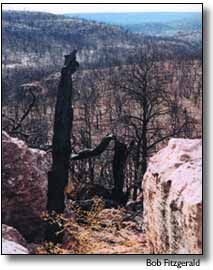|
Nov. 17, 2001
By Janelle Holden A moon-like landscape still greets visitors to Hovenweep Canyon in the Canyons of the Ancients National Monument, more than a year after a fire torched more than 1,500 acres in and around the monument, including Hovenweep Canyon. The blaze raged through the area in July 2000, about the same time that the Bircher and Pony fires were igniting much of Mesa Verde National Park. Those fires burned 21,000 acres in the park and more than 28,000 acres overall. But while park specialists were able to reseed those burned areas shortly after the fires, the BLM took much longer to mount its rehabilitation efforts in the Hovenweep area. A fire-rehabilitation plan done after the Hovenweep burn called for reseeding in the fall of 2000, but due to problems with the reseeding contract, the BLM lost the fall 2000 window and had to wait an extra year. This fall, BLM specialists reseeded 800 acres of the burn by air, hoping that native grasses, shrubs, and forbs would begin sprouting by spring in what was once piñon-juniper forest.
The BLM also reseeded 1,700 acres of another summer 2000 fire, the Hamilton fire in the Dry Creek Basin near Nucla and Naturita. "It should still do some good," said Mike Jensen, a rangeland-management specialist for the BLM. "In the Hovenweep fire and the Dry Creek Basin Hamilton fire, there was still a lot of bare soil, and I think that if we get some moisture and snow this fall then we still should have a pretty good seeding." Jensen said the reseeding was done to protect natural resources in the area, stabilize the watershed, reduce soil erosion, and prevent noxious weeds from sprouting. Some musk thistle has already made its way into the scorched soil. "The ideal time to seed is in the late fall, so that we get the seed on the ground — specifically because we were broadcast-seeding, and the seed just lies on the ground, then it can take advantage of that winter and early spring moisture, and it should start to germinate in the spring," explained Jensen. The seed mixture used was mixed specifically to help revegetate the native habitat wildlife has traditionally used in the areas. Enough grass came up last year for wildlife to at least nibble on, said Jensen. "The wildlife was actually using both the Hovenweep and Hamilton fire, both deer and elk, because there was a natural release of grasses following the fire that came in on their own, and so they were keying in on those areas." said Jensen. If the seeding is a success, deer and elk won’t be the only animals grazing in Hovenweep Canyon. Jensen said that livestock may be permitted back on the one grazing allotment in the burned area as early as next spring. "It’s in Mother Nature’s hands. The way it’s looking now, I think if we get some snow out there, if we get some close-to-normal spring participation, we’re going to see some of this seeding germinate and establish," said Jensen. Lightning strikes caused the Hamilton and Hovenweep fires as well as the fires at Mesa Verde. They were fueled by drought and hot weather. |
||||
|
Copyright © 2001 the Cortez Journal.
All rights reserved. |
